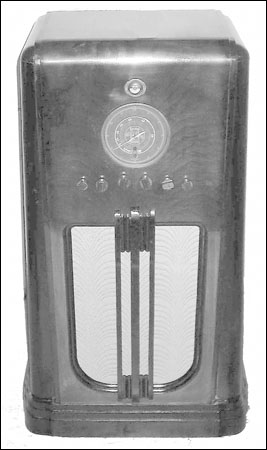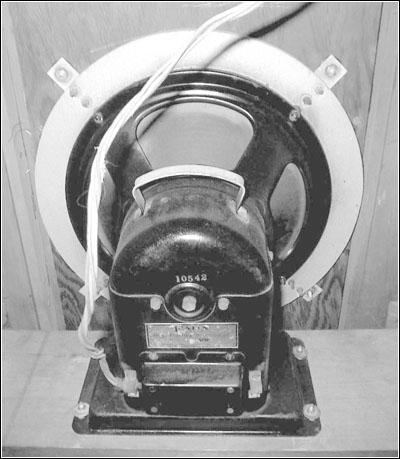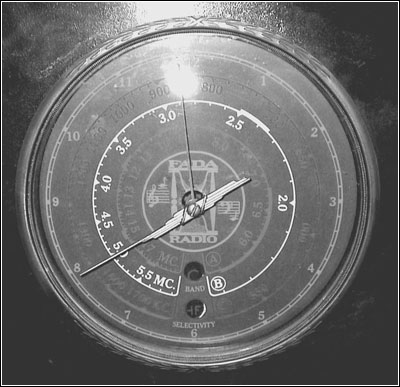Of Old Radios And Related Items--Published Monthly
Refinishing a Fada Model 290C Cabinet
BY CLAUDE CHAFIN
Web Update
With patience, muscle power, and the right materials, Claude Chafin turned a pitiful looking cabinet into showcase condition. (Editor)
The 1937 Fada Model 290C is a 9-tube, 3-band radio. It features vernier tuning, a tuning eye, selectivity switching, off-on tone control, and a hi-fi 12-inch speaker. Photos of the restored console are shown in Figures 1, 2 and 3.
I found this radio in Boone County, Missouri. It had been completely recapped with an amateurish restoration job; in other words, it played well but looked pitiful.
I had never seen this radio here in the Midwest, so I thought I would buy it and restore it to showcase condition -- all new lacquer, toner and black lacquer trim, just as it had been originally.
The Process
Refinishing a console is quite an undertaking. There is a lot of surface area to strip off and refinish. But, if you are up to the task, then start by stripping it in sections; i.e. top, sides, etc. Use 150-grit sandpaper to get down to the wood, and use a wooden block so you don't sand unevenly. Once the old finish is removed, allow the cabinet to dry for 24 hours.
Figure 1. The refinished cabinet and new grille cloth give this 1937 Fada 290C a fresh-from-the-factory look.
Figure 2. The large and heavy speaker for the Fada 290C.Check for cracks, missing veneer, or poor glue joints on and under the veneer. A host of different glue clamps is handy to have at this point. (When I am out collecting, I always look for glue clamps.) Be sure to sand off any excess dried glue.
The next step involves a sanding sealer which seals up the pores in the wood prior to applying the lacquer. Otherwise, the lacquer will soak right into the wood. This is how you get that "piano finish." Use 0000 steel wool to get the dried sanding sealer smooth. Then apply the lacquer and toner. Once the lacquer is applied and dried, buff it with a buffer polish to get that smooth glossy finish. Since this radio has black lacquer trim, I decided it would be a good idea to do the black sections first.
Always avoid using oils and furniture polish. They will soak into the wood and the lacquer will trap it there forever -- not to mention turning everything white.
Replacing the Grille Cloth
I tried to restore the set as close to its original state as possible. The only thing not original is the grille cloth. The original cloth was too far gone to restore, and I didn't like the original cloth style anyway. I used a swirl type reproduction Zenith cloth for the new grille cloth.
Centering the swirls to the grille is a tough job. To do this, I reinstalled the grille board without the cloth to see first how it centered up. I drew a line around the outside so I could see where the edges were after I removed it again. Before removing it, you should mark on the back which edge goes to the top. (This is important later.)
Now it's easy to see where your cloth is to be glued down. Use a fast-tack adhesive very sparingly and a bit of Elmer's Glue around the edges. Once the cloth is glued down and dry, take a pencil-pointed soldering iron and burn holes through the cloth where the screw holes are located. This prevents the screws from snagging on the cloth or even small fibers when installing the grille board.
Figure 3. The tuning dial for the Fada 290C.Burning those holes is very important. If you do it any other way you're asking for trouble. (I learned the hard way.) Your mark on the back tells you which edge is up before installation; if you got it backwards, the screw holes won't line up right.
(Claude Chafin, 4223 E. 42nd Way S, Independence, MO 64055)
Claude Chafin, an antique radio collector for 15 years and a Ham operator for 25, asks three questions before taking on a repair job: Will his techniques bring it back to normal? Is it too far gone to make time spent worthwhile? Does it have good collectible potential? Affirmative answers mean success, as in this article.
| [Free Sample] [Books, etc., For Sale] [Subscribe to A.R.C./Renew] [Classified Ads] [Auction Prices] [Event Calendar] [Links] [Home] [Issue Archives] [Book Reviews] [Subscription Information] [A.R.C. FAQ] URL = http://www.antiqueradio.com/Jul07_Chafin_Fada.html Copyright © 1996-2007 by John V. Terrey - For personal use only. Last revised: June 25, 2007. For Customer Assistance please contact ARC@antiqueradio.com or call (866) 371-0512 toll free Pages designed/maintained by Wayward Fluffy Publications
Antique Radio Classified |


